MBA402 Report: Woolworths Code of Conduct, Ethics, and Governance
VerifiedAdded on 2023/06/09
|10
|2784
|79
Report
AI Summary
This report analyzes the Code of Conduct for Woolworths, a major Australian company, focusing on ethics, governance, and sustainability. The report addresses key areas including the prohibition of discrimination, prevention of exploitation, identification and elimination of corrupt practices, and the elimination of dishonest and fraudulent behavior. It also details the company's approach to whistleblower protection and the enforcement of guiding principles. The analysis examines how Woolworths mitigates legal and ethical compliance issues through its code, with a focus on employee conduct and the protection of company resources. The report utilizes various references to support its findings and includes an introduction, guiding principles, detailed sections on each area of concern, and a conclusion summarizing the recommendations for strengthening the ethical and legal compliance of the company. The report highlights the importance of a strong compliance program, employee relations, and the protection of company assets and reputation.
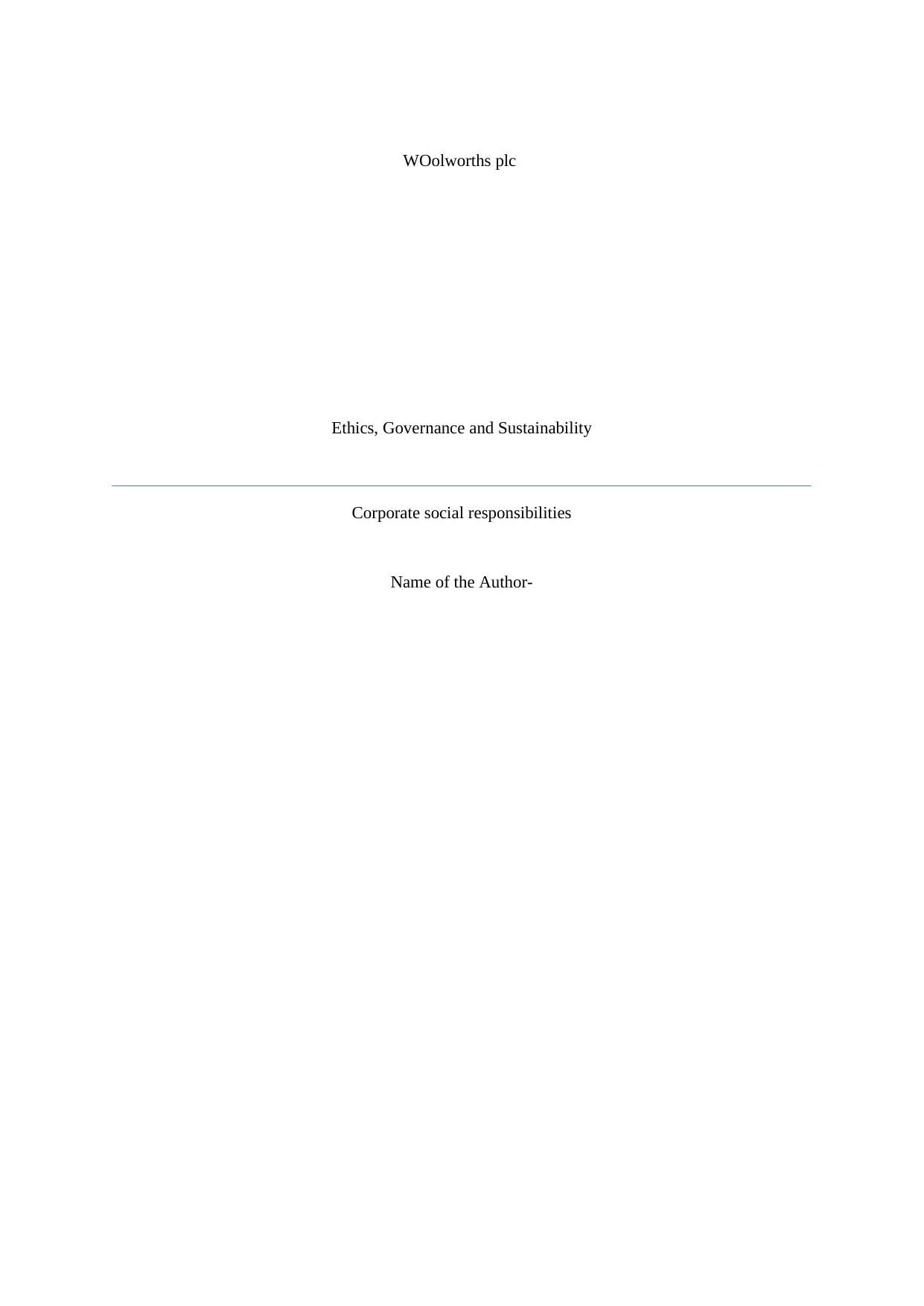
WOolworths plc
Ethics, Governance and Sustainability
Corporate social responsibilities
Name of the Author-
Ethics, Governance and Sustainability
Corporate social responsibilities
Name of the Author-
Paraphrase This Document
Need a fresh take? Get an instant paraphrase of this document with our AI Paraphraser
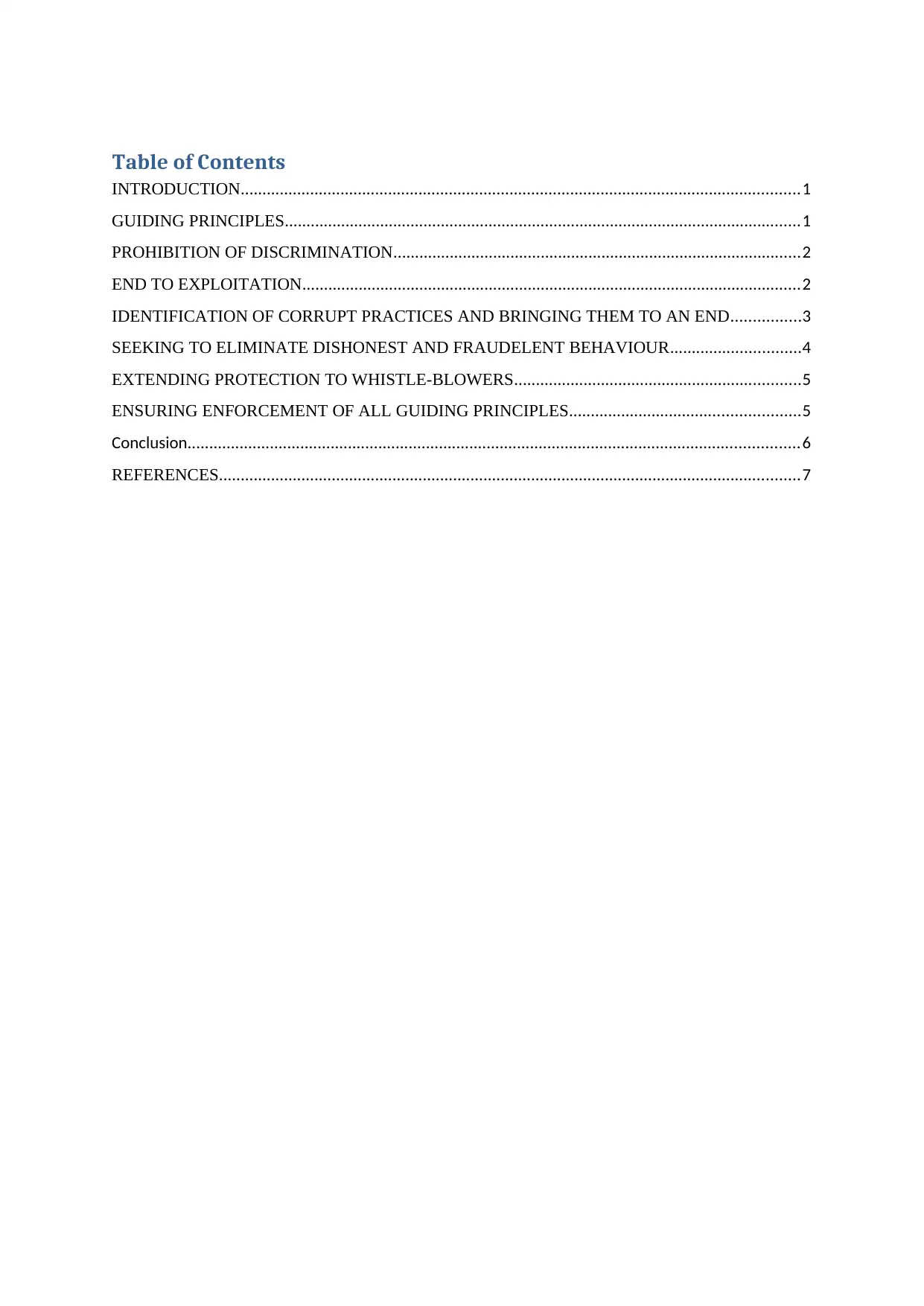
Table of Contents
INTRODUCTION.................................................................................................................................1
GUIDING PRINCIPLES.......................................................................................................................1
PROHIBITION OF DISCRIMINATION..............................................................................................2
END TO EXPLOITATION...................................................................................................................2
IDENTIFICATION OF CORRUPT PRACTICES AND BRINGING THEM TO AN END................3
SEEKING TO ELIMINATE DISHONEST AND FRAUDELENT BEHAVIOUR..............................4
EXTENDING PROTECTION TO WHISTLE-BLOWERS..................................................................5
ENSURING ENFORCEMENT OF ALL GUIDING PRINCIPLES.....................................................5
Conclusion.............................................................................................................................................6
REFERENCES......................................................................................................................................7
INTRODUCTION.................................................................................................................................1
GUIDING PRINCIPLES.......................................................................................................................1
PROHIBITION OF DISCRIMINATION..............................................................................................2
END TO EXPLOITATION...................................................................................................................2
IDENTIFICATION OF CORRUPT PRACTICES AND BRINGING THEM TO AN END................3
SEEKING TO ELIMINATE DISHONEST AND FRAUDELENT BEHAVIOUR..............................4
EXTENDING PROTECTION TO WHISTLE-BLOWERS..................................................................5
ENSURING ENFORCEMENT OF ALL GUIDING PRINCIPLES.....................................................5
Conclusion.............................................................................................................................................6
REFERENCES......................................................................................................................................7
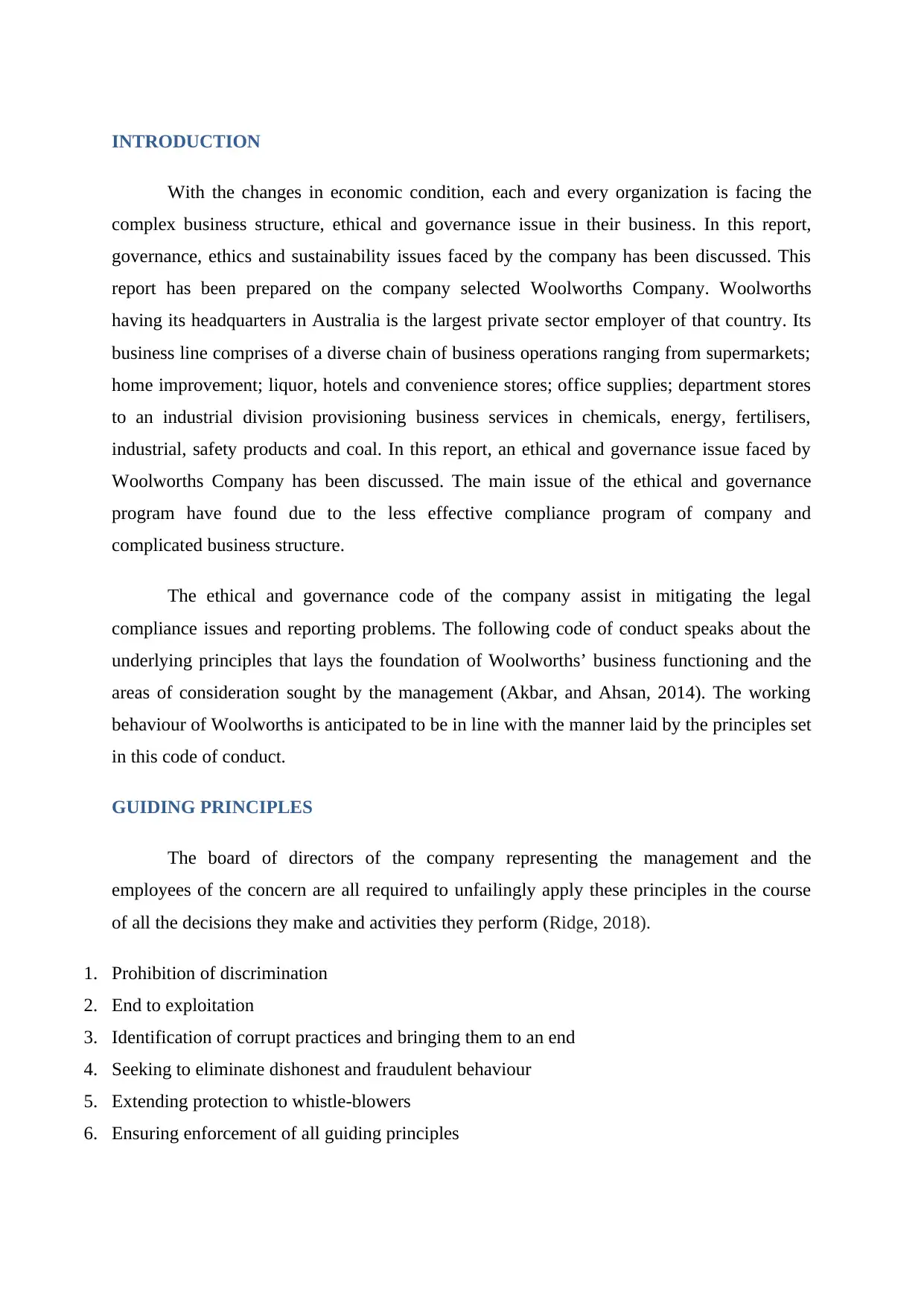
INTRODUCTION
With the changes in economic condition, each and every organization is facing the
complex business structure, ethical and governance issue in their business. In this report,
governance, ethics and sustainability issues faced by the company has been discussed. This
report has been prepared on the company selected Woolworths Company. Woolworths
having its headquarters in Australia is the largest private sector employer of that country. Its
business line comprises of a diverse chain of business operations ranging from supermarkets;
home improvement; liquor, hotels and convenience stores; office supplies; department stores
to an industrial division provisioning business services in chemicals, energy, fertilisers,
industrial, safety products and coal. In this report, an ethical and governance issue faced by
Woolworths Company has been discussed. The main issue of the ethical and governance
program have found due to the less effective compliance program of company and
complicated business structure.
The ethical and governance code of the company assist in mitigating the legal
compliance issues and reporting problems. The following code of conduct speaks about the
underlying principles that lays the foundation of Woolworths’ business functioning and the
areas of consideration sought by the management (Akbar, and Ahsan, 2014). The working
behaviour of Woolworths is anticipated to be in line with the manner laid by the principles set
in this code of conduct.
GUIDING PRINCIPLES
The board of directors of the company representing the management and the
employees of the concern are all required to unfailingly apply these principles in the course
of all the decisions they make and activities they perform (Ridge, 2018).
1. Prohibition of discrimination
2. End to exploitation
3. Identification of corrupt practices and bringing them to an end
4. Seeking to eliminate dishonest and fraudulent behaviour
5. Extending protection to whistle-blowers
6. Ensuring enforcement of all guiding principles
With the changes in economic condition, each and every organization is facing the
complex business structure, ethical and governance issue in their business. In this report,
governance, ethics and sustainability issues faced by the company has been discussed. This
report has been prepared on the company selected Woolworths Company. Woolworths
having its headquarters in Australia is the largest private sector employer of that country. Its
business line comprises of a diverse chain of business operations ranging from supermarkets;
home improvement; liquor, hotels and convenience stores; office supplies; department stores
to an industrial division provisioning business services in chemicals, energy, fertilisers,
industrial, safety products and coal. In this report, an ethical and governance issue faced by
Woolworths Company has been discussed. The main issue of the ethical and governance
program have found due to the less effective compliance program of company and
complicated business structure.
The ethical and governance code of the company assist in mitigating the legal
compliance issues and reporting problems. The following code of conduct speaks about the
underlying principles that lays the foundation of Woolworths’ business functioning and the
areas of consideration sought by the management (Akbar, and Ahsan, 2014). The working
behaviour of Woolworths is anticipated to be in line with the manner laid by the principles set
in this code of conduct.
GUIDING PRINCIPLES
The board of directors of the company representing the management and the
employees of the concern are all required to unfailingly apply these principles in the course
of all the decisions they make and activities they perform (Ridge, 2018).
1. Prohibition of discrimination
2. End to exploitation
3. Identification of corrupt practices and bringing them to an end
4. Seeking to eliminate dishonest and fraudulent behaviour
5. Extending protection to whistle-blowers
6. Ensuring enforcement of all guiding principles
⊘ This is a preview!⊘
Do you want full access?
Subscribe today to unlock all pages.

Trusted by 1+ million students worldwide

After analysing the annual report of company, it is inferred that company has
complied with these principles with a view to strengthen its ethical and legal compliance
program. It will not only increase the overall outcomes but also assist organization to mitigate
its legal and ethical issues.
PROHIBITION OF DISCRIMINATION
Discrimination stands for treating different group of people prejudicially on the roots
of ethnicity, race, age, sex, nationality, etc. Different examples of discrimination include
harassing people by making insulting jokes on them, using cartoons and caricatures defaming
them on grounds of race, colour, religion, etc. (Johnson, et al. 2015). Discrimination could be
in form of offering of different wages to different employees having same set of skills and
doing same job; offering different hiring process; firing from job in case of any medical
emergency like pregnancy, injury or sickness; offering different pay benefits to different
employees. In the latest, company has faced issue of harmonization in the domestic and
international rules and regulations. The consequences of the non-compliance with these laws
have lead company to face high penalty and destruction in its business in long run.
Woolworth has made policies and program to mitigate the process related issues and ethical
frauds which might lower down the destruction of the process system and increase the overall
outcomes of the business.
Any sort of discrimination that may even be veiled under the tag of a joke shall not be
entertained and is strictly declared as unlawful. It is analyzed that company has mitigated
several issues and problems due to the legal compliance program and negative business
outcomes. There need to be mutual respect among peers having diverse cultural, regional,
geographical spheres. Any promotion or any other work related award is stringently to be
made on the basis of skill, professionalism and merit (Neilsen, 2015). The employees must
support and grow in a harmonised manner. Further outcomes of non-adherence of same are
discussed in enforcement section.
END TO EXPLOITATION
Exploitation as a generic term stands to the unfair treatment made towards certain
people with a view of getting advantage out of the work done by them. It may stand at two
spheres: one at the end of exploitation towards employees that include bad working
conditions, underpayment, depriving workers from basic rights etc. and other at the
complied with these principles with a view to strengthen its ethical and legal compliance
program. It will not only increase the overall outcomes but also assist organization to mitigate
its legal and ethical issues.
PROHIBITION OF DISCRIMINATION
Discrimination stands for treating different group of people prejudicially on the roots
of ethnicity, race, age, sex, nationality, etc. Different examples of discrimination include
harassing people by making insulting jokes on them, using cartoons and caricatures defaming
them on grounds of race, colour, religion, etc. (Johnson, et al. 2015). Discrimination could be
in form of offering of different wages to different employees having same set of skills and
doing same job; offering different hiring process; firing from job in case of any medical
emergency like pregnancy, injury or sickness; offering different pay benefits to different
employees. In the latest, company has faced issue of harmonization in the domestic and
international rules and regulations. The consequences of the non-compliance with these laws
have lead company to face high penalty and destruction in its business in long run.
Woolworth has made policies and program to mitigate the process related issues and ethical
frauds which might lower down the destruction of the process system and increase the overall
outcomes of the business.
Any sort of discrimination that may even be veiled under the tag of a joke shall not be
entertained and is strictly declared as unlawful. It is analyzed that company has mitigated
several issues and problems due to the legal compliance program and negative business
outcomes. There need to be mutual respect among peers having diverse cultural, regional,
geographical spheres. Any promotion or any other work related award is stringently to be
made on the basis of skill, professionalism and merit (Neilsen, 2015). The employees must
support and grow in a harmonised manner. Further outcomes of non-adherence of same are
discussed in enforcement section.
END TO EXPLOITATION
Exploitation as a generic term stands to the unfair treatment made towards certain
people with a view of getting advantage out of the work done by them. It may stand at two
spheres: one at the end of exploitation towards employees that include bad working
conditions, underpayment, depriving workers from basic rights etc. and other at the
Paraphrase This Document
Need a fresh take? Get an instant paraphrase of this document with our AI Paraphraser

exploitation of Woolworths’ resources and information system (Kennedy, Welch and,
Monshipouri, 2017).
There must be no ill treatment of employees and they should be paid well as per their
requisite skills. Overtime must be paid separately. The property; finance and facilities like
internet, telephone, facsimile of Woolworths should be judiciously used and after getting due
permissions from senior management. For bringing own devices, the employees must first
obtain proper sanctions from senior management (Garba, et al. 2015). Similarly any
detachments of office devices for taking home should be completely authorised.
Use of public portals from office internet and other social networking sites must go in
accordance with the charter of information system policies. Proper enforcement is expected
and any loopholes shall be dealt as mentioned in enforcement section.
IDENTIFICATION OF CORRUPT PRACTICES AND BRINGING THEM TO AN
END
Corrupt practices are the ones where the people who are commended with high level
of authority act in their personal interest and dishonestly to acquire benefit for themselves. In
simple words, it’s the misuse of power by those having the authority to exercise it. Corruptive
practices may involve accepting bribes, secret commissions, money laundering etc. Such
practices are firmly verboten (Iyer, and Samociuk, 2016). These corrupt practices not only
increase the overall complexity of the work process but also lower down the overall outcomes
of the organization.
Anti-corruption policies are the main policies which assist organization to mitigate
possible issues and bribery issues in the business. These set policies and program includes
following details which are given as below (Feigin, 2016).
The employees and the senior management must not engage themselves in accepting bribes,
negotiated commissions for rendering services unofficially, money for passing tenders and
any other illegal payment (Teichmann, 2017).
Non-acceptance of any gifts, amusement facility or any generosity of illegitimate value.
Non-acceptance of any gifts, amusement facility or any generosity which may cause the
employees or management to work under any influence of the person offering the benefit.
Any out of book transaction of dealing with any client must be avoided.
Monshipouri, 2017).
There must be no ill treatment of employees and they should be paid well as per their
requisite skills. Overtime must be paid separately. The property; finance and facilities like
internet, telephone, facsimile of Woolworths should be judiciously used and after getting due
permissions from senior management. For bringing own devices, the employees must first
obtain proper sanctions from senior management (Garba, et al. 2015). Similarly any
detachments of office devices for taking home should be completely authorised.
Use of public portals from office internet and other social networking sites must go in
accordance with the charter of information system policies. Proper enforcement is expected
and any loopholes shall be dealt as mentioned in enforcement section.
IDENTIFICATION OF CORRUPT PRACTICES AND BRINGING THEM TO AN
END
Corrupt practices are the ones where the people who are commended with high level
of authority act in their personal interest and dishonestly to acquire benefit for themselves. In
simple words, it’s the misuse of power by those having the authority to exercise it. Corruptive
practices may involve accepting bribes, secret commissions, money laundering etc. Such
practices are firmly verboten (Iyer, and Samociuk, 2016). These corrupt practices not only
increase the overall complexity of the work process but also lower down the overall outcomes
of the organization.
Anti-corruption policies are the main policies which assist organization to mitigate
possible issues and bribery issues in the business. These set policies and program includes
following details which are given as below (Feigin, 2016).
The employees and the senior management must not engage themselves in accepting bribes,
negotiated commissions for rendering services unofficially, money for passing tenders and
any other illegal payment (Teichmann, 2017).
Non-acceptance of any gifts, amusement facility or any generosity of illegitimate value.
Non-acceptance of any gifts, amusement facility or any generosity which may cause the
employees or management to work under any influence of the person offering the benefit.
Any out of book transaction of dealing with any client must be avoided.
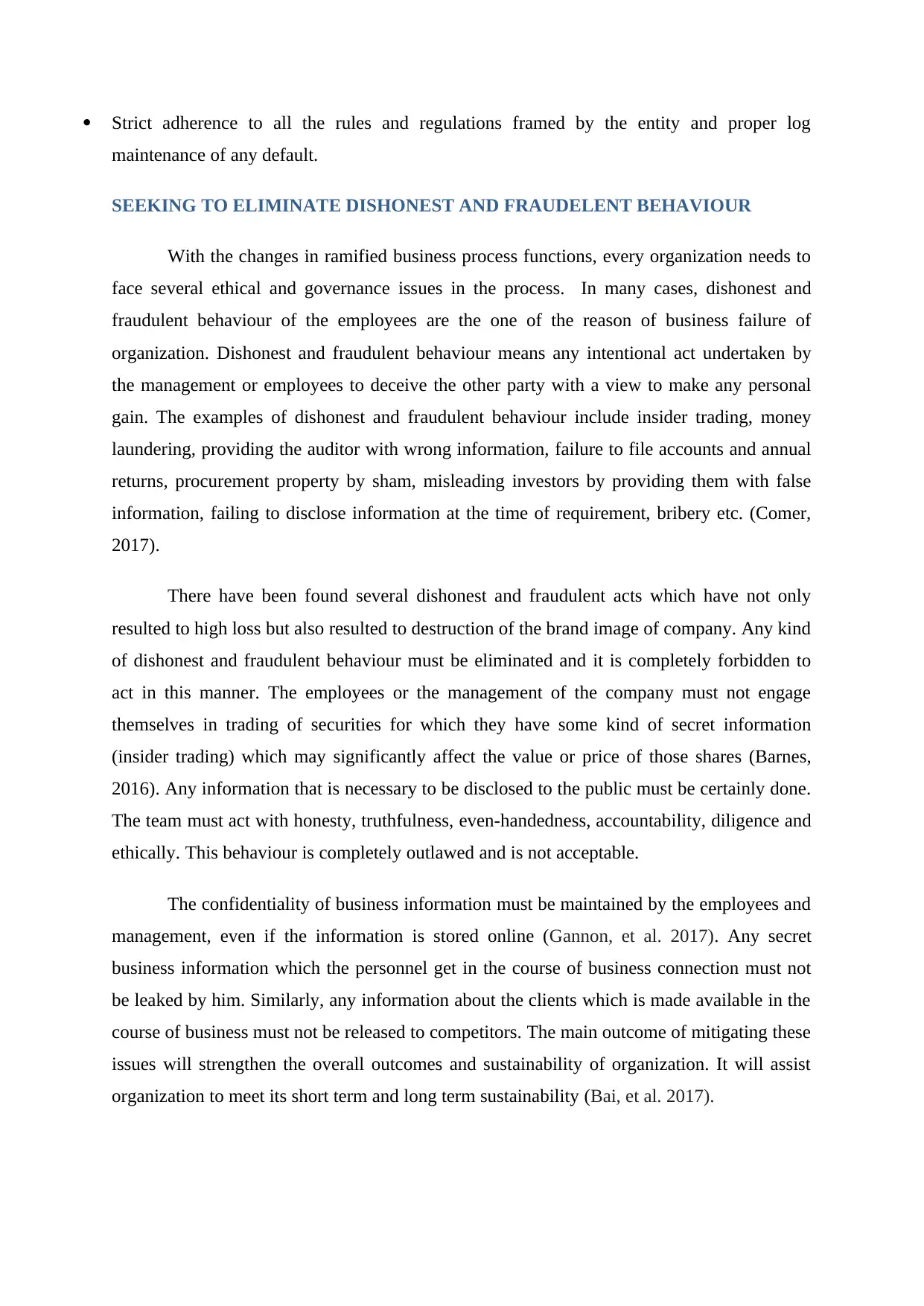
Strict adherence to all the rules and regulations framed by the entity and proper log
maintenance of any default.
SEEKING TO ELIMINATE DISHONEST AND FRAUDELENT BEHAVIOUR
With the changes in ramified business process functions, every organization needs to
face several ethical and governance issues in the process. In many cases, dishonest and
fraudulent behaviour of the employees are the one of the reason of business failure of
organization. Dishonest and fraudulent behaviour means any intentional act undertaken by
the management or employees to deceive the other party with a view to make any personal
gain. The examples of dishonest and fraudulent behaviour include insider trading, money
laundering, providing the auditor with wrong information, failure to file accounts and annual
returns, procurement property by sham, misleading investors by providing them with false
information, failing to disclose information at the time of requirement, bribery etc. (Comer,
2017).
There have been found several dishonest and fraudulent acts which have not only
resulted to high loss but also resulted to destruction of the brand image of company. Any kind
of dishonest and fraudulent behaviour must be eliminated and it is completely forbidden to
act in this manner. The employees or the management of the company must not engage
themselves in trading of securities for which they have some kind of secret information
(insider trading) which may significantly affect the value or price of those shares (Barnes,
2016). Any information that is necessary to be disclosed to the public must be certainly done.
The team must act with honesty, truthfulness, even-handedness, accountability, diligence and
ethically. This behaviour is completely outlawed and is not acceptable.
The confidentiality of business information must be maintained by the employees and
management, even if the information is stored online (Gannon, et al. 2017). Any secret
business information which the personnel get in the course of business connection must not
be leaked by him. Similarly, any information about the clients which is made available in the
course of business must not be released to competitors. The main outcome of mitigating these
issues will strengthen the overall outcomes and sustainability of organization. It will assist
organization to meet its short term and long term sustainability (Bai, et al. 2017).
maintenance of any default.
SEEKING TO ELIMINATE DISHONEST AND FRAUDELENT BEHAVIOUR
With the changes in ramified business process functions, every organization needs to
face several ethical and governance issues in the process. In many cases, dishonest and
fraudulent behaviour of the employees are the one of the reason of business failure of
organization. Dishonest and fraudulent behaviour means any intentional act undertaken by
the management or employees to deceive the other party with a view to make any personal
gain. The examples of dishonest and fraudulent behaviour include insider trading, money
laundering, providing the auditor with wrong information, failure to file accounts and annual
returns, procurement property by sham, misleading investors by providing them with false
information, failing to disclose information at the time of requirement, bribery etc. (Comer,
2017).
There have been found several dishonest and fraudulent acts which have not only
resulted to high loss but also resulted to destruction of the brand image of company. Any kind
of dishonest and fraudulent behaviour must be eliminated and it is completely forbidden to
act in this manner. The employees or the management of the company must not engage
themselves in trading of securities for which they have some kind of secret information
(insider trading) which may significantly affect the value or price of those shares (Barnes,
2016). Any information that is necessary to be disclosed to the public must be certainly done.
The team must act with honesty, truthfulness, even-handedness, accountability, diligence and
ethically. This behaviour is completely outlawed and is not acceptable.
The confidentiality of business information must be maintained by the employees and
management, even if the information is stored online (Gannon, et al. 2017). Any secret
business information which the personnel get in the course of business connection must not
be leaked by him. Similarly, any information about the clients which is made available in the
course of business must not be released to competitors. The main outcome of mitigating these
issues will strengthen the overall outcomes and sustainability of organization. It will assist
organization to meet its short term and long term sustainability (Bai, et al. 2017).
⊘ This is a preview!⊘
Do you want full access?
Subscribe today to unlock all pages.

Trusted by 1+ million students worldwide
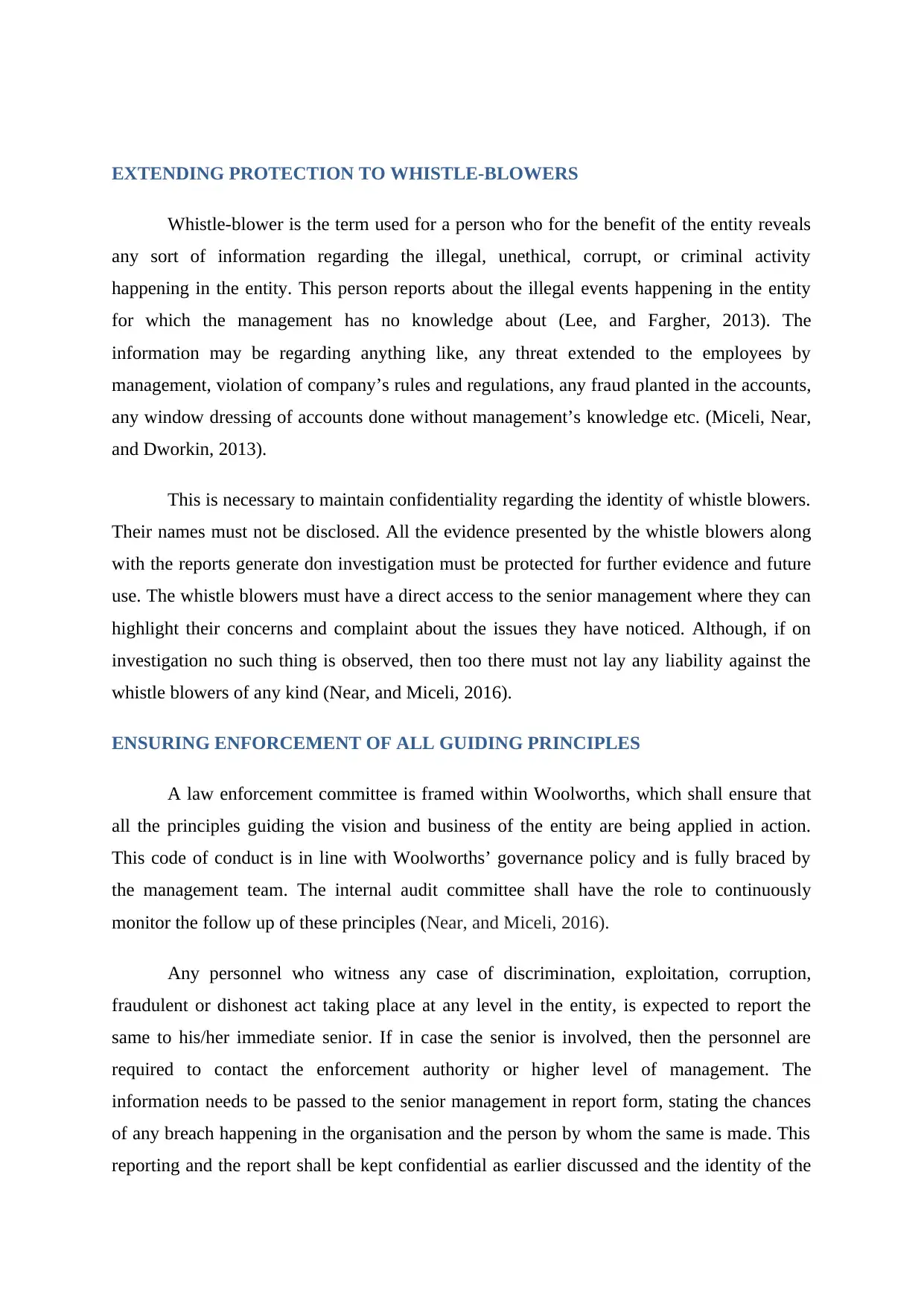
EXTENDING PROTECTION TO WHISTLE-BLOWERS
Whistle-blower is the term used for a person who for the benefit of the entity reveals
any sort of information regarding the illegal, unethical, corrupt, or criminal activity
happening in the entity. This person reports about the illegal events happening in the entity
for which the management has no knowledge about (Lee, and Fargher, 2013). The
information may be regarding anything like, any threat extended to the employees by
management, violation of company’s rules and regulations, any fraud planted in the accounts,
any window dressing of accounts done without management’s knowledge etc. (Miceli, Near,
and Dworkin, 2013).
This is necessary to maintain confidentiality regarding the identity of whistle blowers.
Their names must not be disclosed. All the evidence presented by the whistle blowers along
with the reports generate don investigation must be protected for further evidence and future
use. The whistle blowers must have a direct access to the senior management where they can
highlight their concerns and complaint about the issues they have noticed. Although, if on
investigation no such thing is observed, then too there must not lay any liability against the
whistle blowers of any kind (Near, and Miceli, 2016).
ENSURING ENFORCEMENT OF ALL GUIDING PRINCIPLES
A law enforcement committee is framed within Woolworths, which shall ensure that
all the principles guiding the vision and business of the entity are being applied in action.
This code of conduct is in line with Woolworths’ governance policy and is fully braced by
the management team. The internal audit committee shall have the role to continuously
monitor the follow up of these principles (Near, and Miceli, 2016).
Any personnel who witness any case of discrimination, exploitation, corruption,
fraudulent or dishonest act taking place at any level in the entity, is expected to report the
same to his/her immediate senior. If in case the senior is involved, then the personnel are
required to contact the enforcement authority or higher level of management. The
information needs to be passed to the senior management in report form, stating the chances
of any breach happening in the organisation and the person by whom the same is made. This
reporting and the report shall be kept confidential as earlier discussed and the identity of the
Whistle-blower is the term used for a person who for the benefit of the entity reveals
any sort of information regarding the illegal, unethical, corrupt, or criminal activity
happening in the entity. This person reports about the illegal events happening in the entity
for which the management has no knowledge about (Lee, and Fargher, 2013). The
information may be regarding anything like, any threat extended to the employees by
management, violation of company’s rules and regulations, any fraud planted in the accounts,
any window dressing of accounts done without management’s knowledge etc. (Miceli, Near,
and Dworkin, 2013).
This is necessary to maintain confidentiality regarding the identity of whistle blowers.
Their names must not be disclosed. All the evidence presented by the whistle blowers along
with the reports generate don investigation must be protected for further evidence and future
use. The whistle blowers must have a direct access to the senior management where they can
highlight their concerns and complaint about the issues they have noticed. Although, if on
investigation no such thing is observed, then too there must not lay any liability against the
whistle blowers of any kind (Near, and Miceli, 2016).
ENSURING ENFORCEMENT OF ALL GUIDING PRINCIPLES
A law enforcement committee is framed within Woolworths, which shall ensure that
all the principles guiding the vision and business of the entity are being applied in action.
This code of conduct is in line with Woolworths’ governance policy and is fully braced by
the management team. The internal audit committee shall have the role to continuously
monitor the follow up of these principles (Near, and Miceli, 2016).
Any personnel who witness any case of discrimination, exploitation, corruption,
fraudulent or dishonest act taking place at any level in the entity, is expected to report the
same to his/her immediate senior. If in case the senior is involved, then the personnel are
required to contact the enforcement authority or higher level of management. The
information needs to be passed to the senior management in report form, stating the chances
of any breach happening in the organisation and the person by whom the same is made. This
reporting and the report shall be kept confidential as earlier discussed and the identity of the
Paraphrase This Document
Need a fresh take? Get an instant paraphrase of this document with our AI Paraphraser
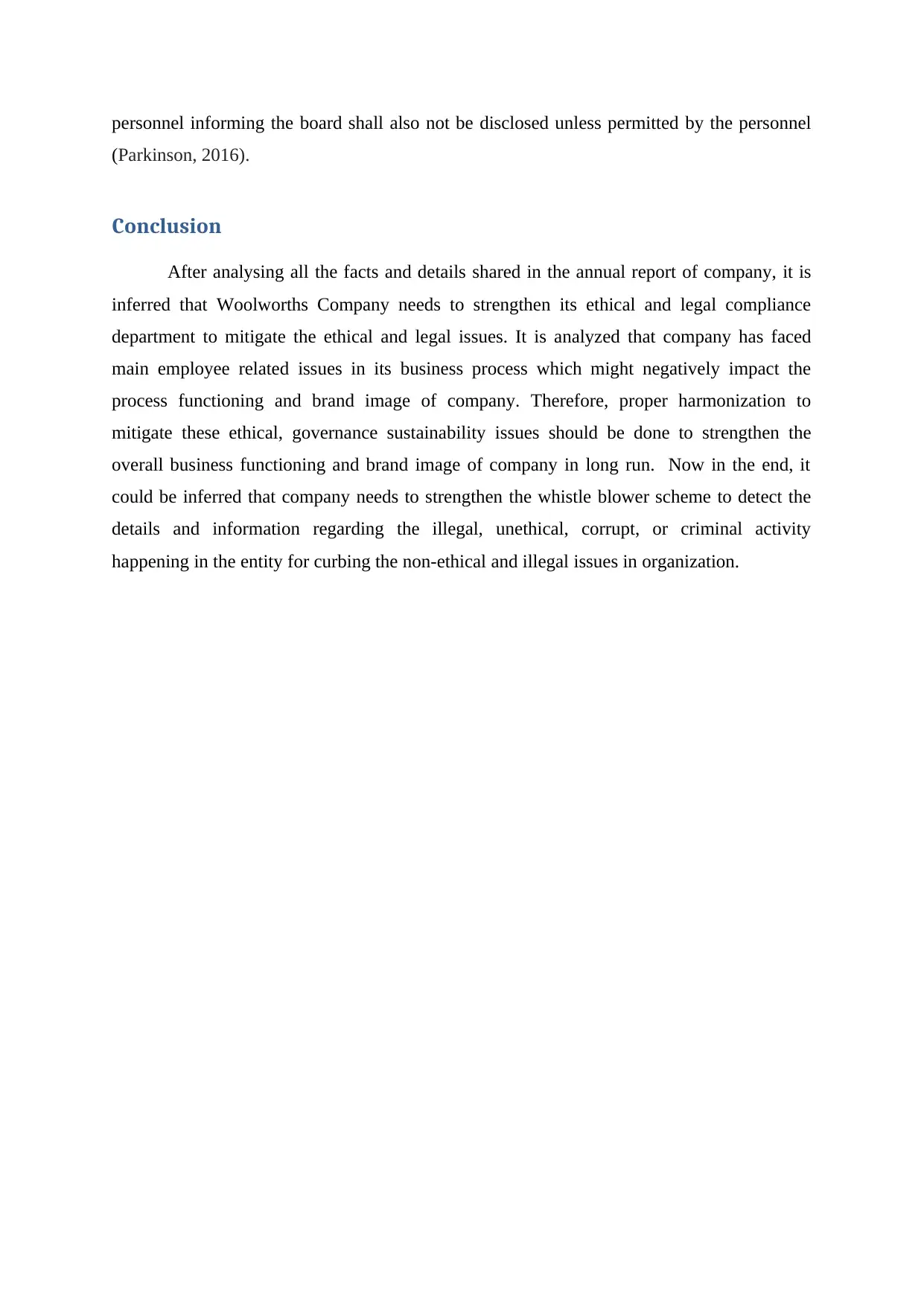
personnel informing the board shall also not be disclosed unless permitted by the personnel
(Parkinson, 2016).
Conclusion
After analysing all the facts and details shared in the annual report of company, it is
inferred that Woolworths Company needs to strengthen its ethical and legal compliance
department to mitigate the ethical and legal issues. It is analyzed that company has faced
main employee related issues in its business process which might negatively impact the
process functioning and brand image of company. Therefore, proper harmonization to
mitigate these ethical, governance sustainability issues should be done to strengthen the
overall business functioning and brand image of company in long run. Now in the end, it
could be inferred that company needs to strengthen the whistle blower scheme to detect the
details and information regarding the illegal, unethical, corrupt, or criminal activity
happening in the entity for curbing the non-ethical and illegal issues in organization.
(Parkinson, 2016).
Conclusion
After analysing all the facts and details shared in the annual report of company, it is
inferred that Woolworths Company needs to strengthen its ethical and legal compliance
department to mitigate the ethical and legal issues. It is analyzed that company has faced
main employee related issues in its business process which might negatively impact the
process functioning and brand image of company. Therefore, proper harmonization to
mitigate these ethical, governance sustainability issues should be done to strengthen the
overall business functioning and brand image of company in long run. Now in the end, it
could be inferred that company needs to strengthen the whistle blower scheme to detect the
details and information regarding the illegal, unethical, corrupt, or criminal activity
happening in the entity for curbing the non-ethical and illegal issues in organization.

REFERENCES
Akbar, S. and Ahsan, K., 2014. Analysis of corporate social disclosure practices of Australian
retail firms. International Journal of Managerial and Financial Accounting, 6(4), pp.375-
396.
Bai, L., Shen, E., Yang, J., Cai, J. and Song, X., 2017. Analysis on the Ethical and Legal
Issues of Big Data of Biobank. Chinese Medical Ethics, 30(10), pp.1206-1212.
Barnes, P., 2016. Stock market efficiency, insider dealing and market abuse. Gower.
Comer, M.J., 2017. Corporate fraud. Routledge.
Feigin, L.M., 2016. The effects of protests and boycotts on a brand and its reputation: a case
study on Woolworths and boycott, divestment and sanctions (BDS) (Doctoral dissertation,
The IIE).
Gannon, M.A., Hurwitz, J.B., Kane, J.R., Kravitz, D.W. and Kuhlman, D.A., Motorola
Solutions Inc, 2017. Stimulus/response-based binding of identifiers across information
domains while maintaining confidentiality. U.S. Patent 9,595,039.
Garba, A.B., Armarego, J., Murray, D. and Kenworthy, W., 2015. Review of the information
security and privacy challenges in Bring Your Own Device (BYOD) environments. Journal
of Information privacy and security, 11(1), pp.38-54.
Iyer, N. and Samociuk, M., 2016. Fraud and corruption: Prevention and detection.
Routledge.
Johnson, S.L., Boutain, D.M., Tsai, J.H.C. and De Castro, A.B., 2015. An investigation of
organizational and regulatory discourses of workplace bullying. Workplace health & safety,
63(10), pp.452-461.
Kennedy, E.T., Welch, C.E. and Monshipouri, M., 2017. Multinational corporations and the
ethics of global responsibility: Problems and possibilities. In Human Rights and Corporations
(pp. 123-147). Routledge.
Akbar, S. and Ahsan, K., 2014. Analysis of corporate social disclosure practices of Australian
retail firms. International Journal of Managerial and Financial Accounting, 6(4), pp.375-
396.
Bai, L., Shen, E., Yang, J., Cai, J. and Song, X., 2017. Analysis on the Ethical and Legal
Issues of Big Data of Biobank. Chinese Medical Ethics, 30(10), pp.1206-1212.
Barnes, P., 2016. Stock market efficiency, insider dealing and market abuse. Gower.
Comer, M.J., 2017. Corporate fraud. Routledge.
Feigin, L.M., 2016. The effects of protests and boycotts on a brand and its reputation: a case
study on Woolworths and boycott, divestment and sanctions (BDS) (Doctoral dissertation,
The IIE).
Gannon, M.A., Hurwitz, J.B., Kane, J.R., Kravitz, D.W. and Kuhlman, D.A., Motorola
Solutions Inc, 2017. Stimulus/response-based binding of identifiers across information
domains while maintaining confidentiality. U.S. Patent 9,595,039.
Garba, A.B., Armarego, J., Murray, D. and Kenworthy, W., 2015. Review of the information
security and privacy challenges in Bring Your Own Device (BYOD) environments. Journal
of Information privacy and security, 11(1), pp.38-54.
Iyer, N. and Samociuk, M., 2016. Fraud and corruption: Prevention and detection.
Routledge.
Johnson, S.L., Boutain, D.M., Tsai, J.H.C. and De Castro, A.B., 2015. An investigation of
organizational and regulatory discourses of workplace bullying. Workplace health & safety,
63(10), pp.452-461.
Kennedy, E.T., Welch, C.E. and Monshipouri, M., 2017. Multinational corporations and the
ethics of global responsibility: Problems and possibilities. In Human Rights and Corporations
(pp. 123-147). Routledge.
⊘ This is a preview!⊘
Do you want full access?
Subscribe today to unlock all pages.

Trusted by 1+ million students worldwide
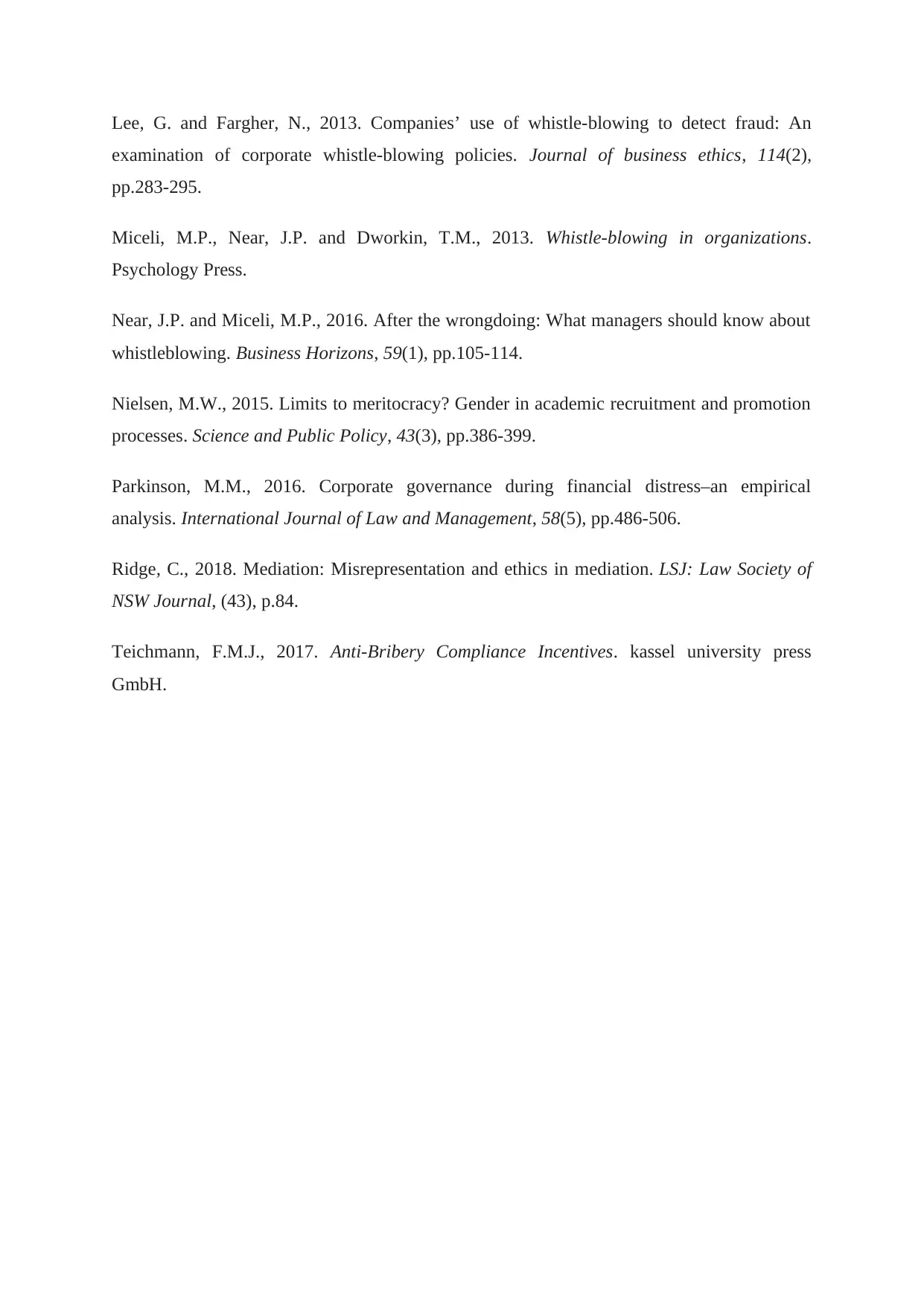
Lee, G. and Fargher, N., 2013. Companies’ use of whistle-blowing to detect fraud: An
examination of corporate whistle-blowing policies. Journal of business ethics, 114(2),
pp.283-295.
Miceli, M.P., Near, J.P. and Dworkin, T.M., 2013. Whistle-blowing in organizations.
Psychology Press.
Near, J.P. and Miceli, M.P., 2016. After the wrongdoing: What managers should know about
whistleblowing. Business Horizons, 59(1), pp.105-114.
Nielsen, M.W., 2015. Limits to meritocracy? Gender in academic recruitment and promotion
processes. Science and Public Policy, 43(3), pp.386-399.
Parkinson, M.M., 2016. Corporate governance during financial distress–an empirical
analysis. International Journal of Law and Management, 58(5), pp.486-506.
Ridge, C., 2018. Mediation: Misrepresentation and ethics in mediation. LSJ: Law Society of
NSW Journal, (43), p.84.
Teichmann, F.M.J., 2017. Anti-Bribery Compliance Incentives. kassel university press
GmbH.
examination of corporate whistle-blowing policies. Journal of business ethics, 114(2),
pp.283-295.
Miceli, M.P., Near, J.P. and Dworkin, T.M., 2013. Whistle-blowing in organizations.
Psychology Press.
Near, J.P. and Miceli, M.P., 2016. After the wrongdoing: What managers should know about
whistleblowing. Business Horizons, 59(1), pp.105-114.
Nielsen, M.W., 2015. Limits to meritocracy? Gender in academic recruitment and promotion
processes. Science and Public Policy, 43(3), pp.386-399.
Parkinson, M.M., 2016. Corporate governance during financial distress–an empirical
analysis. International Journal of Law and Management, 58(5), pp.486-506.
Ridge, C., 2018. Mediation: Misrepresentation and ethics in mediation. LSJ: Law Society of
NSW Journal, (43), p.84.
Teichmann, F.M.J., 2017. Anti-Bribery Compliance Incentives. kassel university press
GmbH.
1 out of 10
Related Documents
Your All-in-One AI-Powered Toolkit for Academic Success.
+13062052269
info@desklib.com
Available 24*7 on WhatsApp / Email
![[object Object]](/_next/static/media/star-bottom.7253800d.svg)
Unlock your academic potential
Copyright © 2020–2025 A2Z Services. All Rights Reserved. Developed and managed by ZUCOL.




